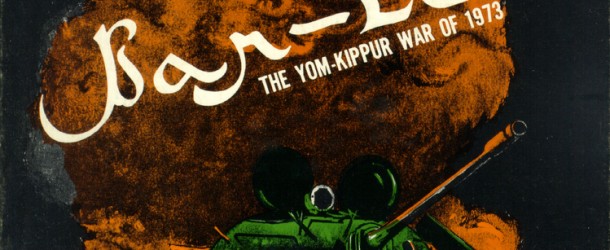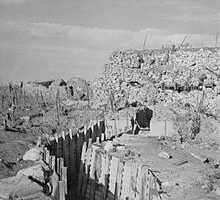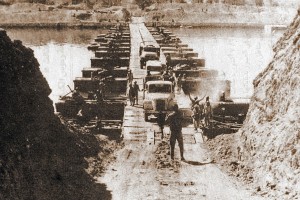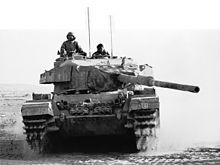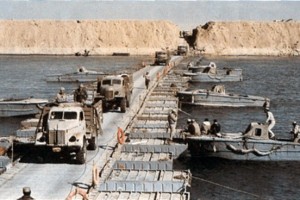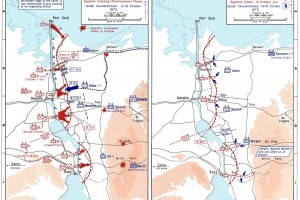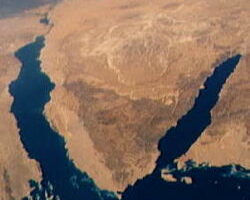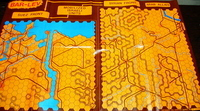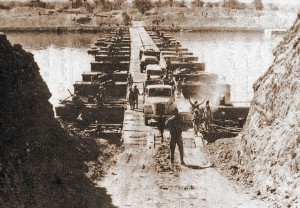Bar Lev: The Yom-Kippur War
By Mitch Freedman
Designer: John Hill, head designer
Publisher: Conflict Games (1974)
Why would anyone want to read a about a game that is almost 40 years old, let alone write about it?
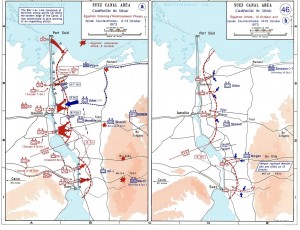 Well, there are lots of answers. One of the best is that sometimes a game manages to give something that stays interesting no matter how long its been around. And while its not exactly fair to compare Bar Lev to Monopoly or Scrabble, it does have a cult following that has never died. On top of that, its innovative combat systems are still fun to play even today.
Well, there are lots of answers. One of the best is that sometimes a game manages to give something that stays interesting no matter how long its been around. And while its not exactly fair to compare Bar Lev to Monopoly or Scrabble, it does have a cult following that has never died. On top of that, its innovative combat systems are still fun to play even today.
Besides, its not quite gone. You can still find copies of Bar Lev out in the world of E-bay, or hanging around a back table at some gaming tournaments. And, there’s something comforting in seeing men who first played Bar Lev in 1974 still arguing over yellowing sheets of errata.
But, what makes it fun?
 Bar Lev broke away from the old war game system of move and fire, counter move and fire in a big way. While most of the games before it had soldiers and tanks and boats with just one combat value – or maybe one for attack and another for defense – Bar Lev managed to integrate air combat and artillery with ground attack, defensive fire from players in villages and higher ground, and surface to air missile defenses, as well as some pretty subtle challenges for both players and an almost certain mid-game shift where the attackers become the defenders.
Bar Lev broke away from the old war game system of move and fire, counter move and fire in a big way. While most of the games before it had soldiers and tanks and boats with just one combat value – or maybe one for attack and another for defense – Bar Lev managed to integrate air combat and artillery with ground attack, defensive fire from players in villages and higher ground, and surface to air missile defenses, as well as some pretty subtle challenges for both players and an almost certain mid-game shift where the attackers become the defenders.
And, just as things are changing and the Israeli player is starting to become strong enough to stop retreating, there’s a sudden death victory option for the Arabs who can win just by clearing the still outnumbered enemy from one of the two combat fronts.
It had the same impact on gaming that Squad Leader did when, suddenly, all of those infantry units could pick up different weapons, and firepower increased when you were making a close assault.
Getting Ready To Play
Setting up Bar Lev can take some time. And, it requires a much bigger table than most games. It also helps to be a bit of a neat freak, but organization really is important.
The Bar Lev map map is actually two maps, one for the Syrian Front, the other for the Egyptian front, linked in the middle by off-board reinforcement boxes. In a later edition released by GDW in 1977, the map was split into two separate maps – along with a lot of other changes – which gave a different look and feel to the game. Even the orange desert of the original classic was replaced, which some people though was a good idea at the time. They also once changed the formula for Classic Coke too.
I like the older system, because it really shows the problem that the Israeli player has in deciding which front gets which reinforcements as the troops are moved from a central reinforcement pool to one of the two combat fronts. It also gives the Arab players a good chance to taunt their foes as they argue over who gets the one really strong tank. Besides, shifting those units from box to box gives your limited helicopters something else to do. But, we’re getting ahead of ourselves. Lets start with the game set-up.
It takes a lot of table space to play Bar Lev. Every one of the hundreds of counters must first be put on a set-up sheet. One for the Israeli forces shows their precise start-up location on the map – or “within three hexes of….” limitations, or shows the day they arrive in the central reinforcement pool.
For the Arab side (and up to four people can play the game), it shows initial set-up or the days and conditions when units can be released from rear area reinforcements, and the various Arab allies and what you need to roll in order to have them enter the battle.
There are also sheets for the Arab allies, and still others where each player stacks his losses. Some units can be refitted as players cannibalize parts from damaged vehicles and aircraft. It allows the Israeli player to get back one unit for each two permanently killed, while the Arab player has a 3-1 trade ratio.
And, while that seems like minor bookkeeping, victory or defeat could be determined by just what units you pick to re-build – two infantry or one tank? Infantry in a half track which will take an extra turn to get on the board but moves faster when it gets there?
And, before you start…….
Despite what looks like a pretty rigid set-up, the Israeli player has some admittedly limited options in placing their troops. And, their side puts units down first, since there was a lot of intelligence before the war and the Arabs could attack pretty much wherever they wanted.
The Arab line of attack – a red line drawn down the center of the hexes on the map in Syria or the Suez Canal on the Egyptian front – is clear. Sacrificing a few key Israeli units by placing them very close to the line could blunt an attack for a turn or two, or make up a vital reserve force in turn two or three by placing them out of immediate harm’s way. Its a big decision. And, since units in villages or on higher elevation get first fire – a chance to kill an opponent before they can shoot back – the shape of Israeli strategy can be seen before the first roll of combat dice.
On the Arab side, placement is even more important. There are so many troops that, at first, its hard for Arab players go through their vast stacks and find the tanks and artillery under the protective SAM air defense rockets lining the Suez Canal.
There are 10 bridges to put down to cross the canal, and a bigger SAM concentration than anywhere outside of Moscow. But, what to do. Only one unit per turn can cross a bridge, and unlike the Israeli player who can move and shoot artillery, the Arab can only move or fire. And, if the Israeli blocks the two hexes at the entrance to the bridge, your units can’t get off, must fight at a disadvantage and – if the bridge hex is attacked – they can sink into the water if the bridge is destroyed.
Its a choice of playing it safe under the protective SAM and artillery shield – and waiting for the longer-range Israeli artillery to show up – or striking out and hoping to have a strong enough counter punch to kill any of the big Israeli units.
And, with only a few limited entrance points on each side of the board, an aggressive Arab player can actually block a critical Israeli reinforcement for one or two key turns.
Finally, as losses start mounting for the Arabs and some of those limited allies come onto the board, it becomes a question of where to put them, and whether to keep Israeli troops in helicopters from hitting you in the rear. They can be effective just by cutting those enemy units out of supply.
So, lets play the game
The heart of Bar Lev is its turn sequence, a rigid list of what to do from the start to the end of a turn. Its a lot more than move and shoot, because it integrates air units, surface to air missiles, artillery and combat movement and attack, along with first fire by any unit in a village or on higher ground.
There is a lot of strategy in this sequence, more than a casual player might realize.
Units can not attack at odds less than than 1-2, so an infantry with a strength of 4 can never shoot at a tank with a strength of 10, first fire or not. That becomes important on the first turn, when the Arabs will face several Israeli positions with a strength of 6, but made up of two counters, a 4 and a 2.
Because attacks come in waves – players don’t just add up air factors and artillery factors to a ground attack, each comes in separately – its possible to neutralize one of those units, or even destroy it before ground combat.
So while the 6 and the 2 units get a 1-2 attack and first fire against an enemy tank rated 8, if one counter is neutralized or killed, no attack is possible. And, if the 8 kills the 4 infantry before it ever gets to move, the 2 unit can’t shoot back in its turn. Which saves some Arab units in most first attacks.
On the defensive side for the Israeli player, there are a couple of “reece jeeps,” weak recon units which have the wonderful ability – or annoying, depending on which side you are playing – to simply pull out of a declared battle before it begins, simply giving up its hex. But they can’t retreat into an enemy zone of control, however, or move if neutralized by air or artillery attack.
There is a whole air module to the game, and the charts break down which aircraft are better at air attack and at ground attack. Study the charts carefully, because a lot depends on how air power is used.
Even without the charts, however, there are consequences. Egypt has three special airborne infantry units, but can’t use them unless it has air superiority – 50% more aircraft assigned to attack other planes. Of course, its best air fighters can also punch holes in the well-fortified Bar Lev line across the Suez Canal while protected by their SAM missile shield, or at least neutralize units there so they can be killed by an artillery barrage. And, surplus air attack units – those extra planes left over after opposing fighters are matched up 1 to 1 – have the option of staying in the battle and improving combat odds or flying off and interdicting ground movement, adding 1 point to leave any hex with an enemy plane in it. And yes, interdicting planes can be shot at by mobile SAM units.
Of course, the Israeli player knows this strategy too, so they may go to the Syrian front, keeping just enough fighters in Egypt to keep the enemy from getting air superiority on the cheap.
The Israeli player also has helicopters – Chinooks which can transport up to two units, and UH-1 Hueys which can take infantry troops in for ground assault. But, there are only four missions allowed each turn, and choppers which fly beyond their range are grounded until someone can bring gas to them, which never seems to happen.
Combat for each side is similar, but not mirror image. The refit procedure, for example, takes place for the Israeli player before his general movement, but at the end of Arab movement and combat, keeping reformed units out of battle for an extra turn.
As the game goes on, the Israeli position generally gets weaker, then holds its own, then gets stronger. The Arabs, on the other hand, are never as strong as on their first move. But a good Arab player can – with a little luck, or some mistakes by their Israeli opponent – really push the game to an instant win.
The Israeli air force is, plane for plane, better than the Arabs. And that yellowing errata sheet says the tempting Mig 23’s in the counter mix really should not be used, since they were never in the air when Egypt attacked across the Suez Canal.
Some of the Israeli artillery has longer range than any Arab guns, and they can move and shoot, while the Arab armies can only move or shoot.
But, the Arab player gets to dictate the pace of the game, and decide whether to go for a minor victory – winning on one front and getting a tie on the other – or going for broke. If opportunity knocks, or things go bad, they can always change their approach.
As the rules say, the game is tilted a bit toward the Israeli player, but one round of bad dice rolling can change that situation very quickly.
Makes it exciting, and worth separating all those 4-6 halftrack counters from the 4-6 M 113’s. For the purists, of course.
Game Resources:
 Bar Lev Errata
Bar Lev Errata
Bar Lev Ground rules
Bar Lev Air Rules


